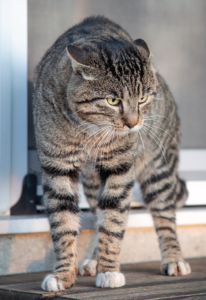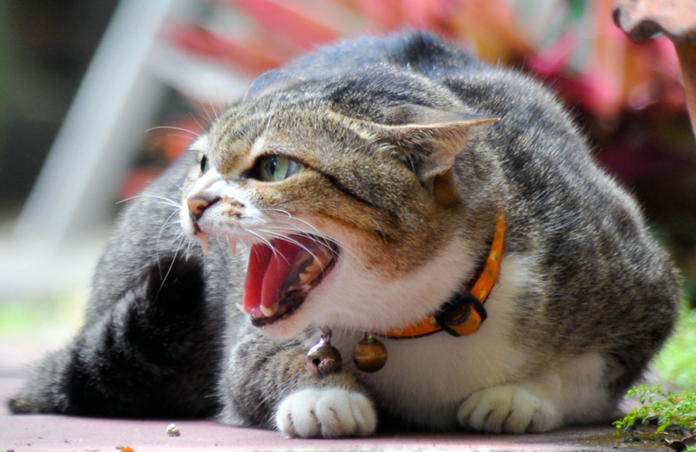About 27% of cat surrenders to shelters are due to aggression problems. That’s sad, really, as most cats provide a warning before an attack, and you can usually prevent it from happening. However, you need to be observant.
If you notice your cat’s stance and expression changing, move away from the cat. Whether aggressive or frightened (see sidebar), your cat may well scratch or bite you. Putting a laundry basket over an upset cat is an option to keep both of you safe in a pinch, but the most important thing is to provide a way for your cat to feel safe and unthreatened.
“The most common situations involving a pet cat and her family are ‘over petting’ and redirected aggression,” explains Katherine A. Houpt, VMD, PhD, James Law Professor Emeritus, Behavior Medicine at the Cornell University’s College of Veterinary Medicine.
Many cats have a limited tolerance level for petting, and things like static electricity or physical pain can make the experience unpleasant (if you suspect pain, it’s time for a veterinary visit). Your cat may warn you that she’s tiring of it by flicking her ears, twitching her tail, or rippling the skin on her back. An onset of hissing or the cessation of purring is a solid hint it’s time to stop.
In redirected aggression, a cat may become excited and redirect her aggression from the stimulus to a person or nearby pet. Redirected aggression can have many inciting causes, such as a sudden loud noise or an unpleasant interaction with another pet (or a stray outside who gets your indoor cat worked up). If you need to break up a fight between your cats, get them separated, but don’t try to console either one. A painful scratch is likely to be your reward.
Handling Aggression
Redirected aggression is one of the most dangerous types of cat aggression because these bites are uninhibited. The attacks can be frightening and damaging. Considerable delay, even hours, can occur between the initial arousal and the redirected aggression.
Some of the best techniques for dealing with an aggressive cat start with management, says Dr. Houpt. For a cat that is easily triggered into redirected aggression by things like cats outside, close off her access to windows. Discourage stray cats (that means no feral-cat feeding stations by your home). Look for triggers and try to minimize them. If you get a new pet, do the introduction slowly and carefully. Reinforce your first cat’s rights to her favorite places.
You can try counter conditioning, which means providing your cat with a positive action when one of her triggers occurs. So, if the new cat comes into the room, give your original cat a special treat, such as a piece of chicken. The goal is to have her associate the new cat with good things happening.
Trained behaviors can prevent an aggressive interaction. For example, train your cat to go to her place—be that a crate, bed, or perch—and when she gets there, give her a special treat. If you see her looking like she’s becoming aggressive, try to intercept and redirect her to her safe spot, which she now associates with a special treat.

Psychoactive medications are available from your veterinarian for extreme cases. Your veterinarian may suggest first trying feline pheromone sprays or collars to see if that helps. Consulting a board-certified veterinary behaviorist (go to dacvb.org to find a qualified veterinarian) can help you implement individualized management techniques for your cat.
Living with an aggressive cat is stressful for all concerned, but it is worth determining the causes behind the aggression to try to prevent attacks. Letting your feline friend end up in a shelter without trying to help her is not an acceptable option.
To learn more about feline aggression and how to manage it, visit the Cornell Feline Health Center’s website (tinyurl.com/CornellCatAggression).
Get Off on the Right Paw

Inappropriate play with your new kitten or young cat can result in some rough stuff later on. Sharp kitten claws and teeth hurt even when it is play, but they can worsen as the cat grows. These actions can be stopped relatively easily as long as everyone in the household is consistent.
No playing using human body parts as toys. That means no foot games or tapping your hand to attract your kitten. While it might be fun if you have a thick sock or slippers on, a bare foot won’t fare well. Don’t encourage your kitten to climb up your pant leg (one day you may be wearing shorts!). Immediately gently detach the kitten and put her down on the floor.
When using a toy such as a tug or a feather wand to chase, always keep your hand away from the action. Have toys scattered around so you can distract and redirect your kitten if she comes barreling in. Watch carefully when playing for signs that your kitten may be getting out of hand. Dilated pupils, ears pinned back, and vocalizations are all warning signals that behavior is moving in a direction that may become aggressive. With maturity, most cats adapt to appropriate play.




